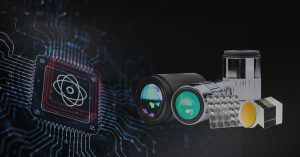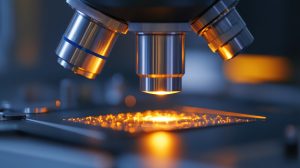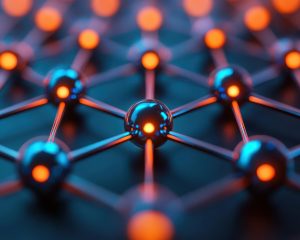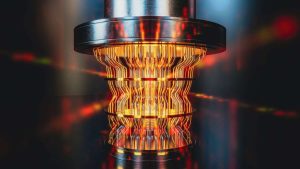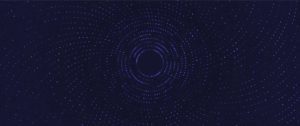Key Takeaways
- Long working distance microscope objectives are essential for ion-trap quantum computing, enabling precise UV laser excitation and high-resolution fluorescence imaging.
- Their extended working distance, wide FOV, and low distortion make them ideal for multi-ion qubit control.
- Avantier’s custom UV objective lens met stringent requirements for 1 µm spot projection, >80% transmission, and diffraction-limited performance, overcoming distortion and thermal stability challenges.
- These innovations advance scalable quantum architectures and set new standards in optical design for quantum computing, photonics, and semiconductor metrology.
Introduction to Long Working Distance Microscope Objectives in Quantum Computing
In quantum computing research, precision optics define the boundary between experimental success and failure. One of the most critical components in ion-trap quantum computers is the long working distance (LWD) microscope objective lens. These specialized ultraviolet (UV) microscope objectives deliver uniform laser excitation and high-resolution fluorescence imaging inside complex vacuum and cryogenic systems, making them indispensable for quantum ion capture experiments.
This application note explores the role of long working distance microscope objectives in quantum computing and presents a detailed case study of a custom Avantier UV objective lens designed for ion-trap systems.
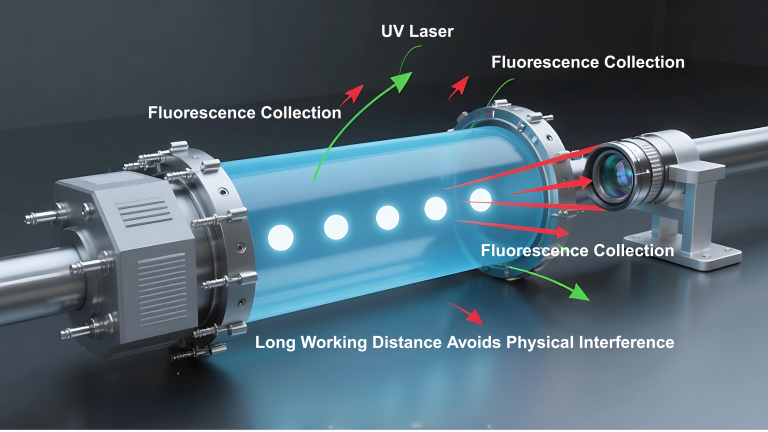
I. Long Working Distance Microscope Objectives in Quantum Computing
Why Long Working Distance Objectives Matter
Quantum computers based on ion traps demand optical systems that can:- Deliver high-throughput laser excitation to trapped ions.
- Collect faint fluorescence signals at UV wavelengths (397–400 nm).
- Operate with minimal distortion and diffraction-limited resolution.
- Maintain sufficient working distance to avoid interference with vacuum chambers and electrodes.
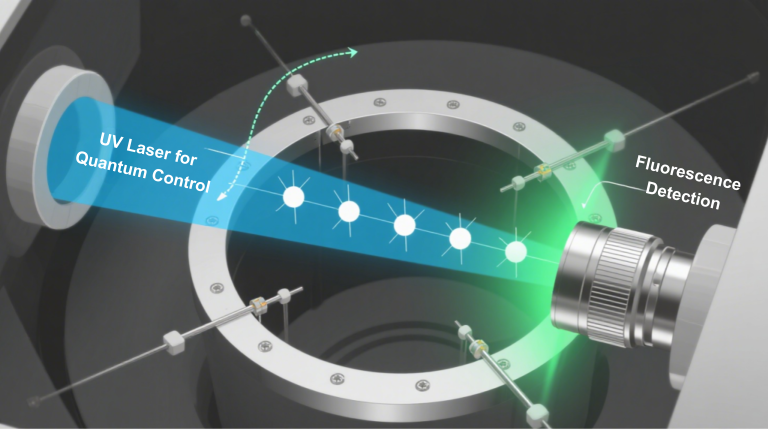
Key Optical Requirements for Ion Capture
- Uniform Laser Distribution – Prevents errors in ion excitation intensity.
- High Fluorescence Collection Efficiency – Critical for capturing weak quantum state signals.
- Wide Field of View – Essential for scaling multi-ion qubit arrays.
- Long Working Distance – Protects against hardware interference while preserving vacuum integrity.
Technical Advantages of LWD Microscope Objectives
- Extended Working Distance: Millimeter-to-centimeter range, compared to <1 mm in standard objectives.
- Wide Field Capability: Supports simultaneous observation of multiple qubits.
- High Resolution: Aberration-corrected optics deliver diffraction-limited imaging.
- Low Distortion: Ensures accurate laser focusing and qubit positioning.
- Multi-Wavelength Performance: Corrects chromatic aberrations for UV laser and fluorescence.
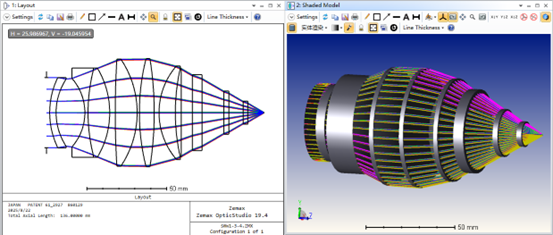
II. Case Study: Avantier’s Custom Long Working Distance UV Objective Lens
Customer Goals
A leading quantum computing research group required a custom UV objective lens with:- 1 µm laser spot projection accuracy for qubit control.
- Distortion under 0.1 µm in the object plane.
- High transmission (>80%) at 397–400 nm.
- Dual use for laser delivery and fluorescence imaging.
Challenges Encountered
- Distortion: First design exceeded tolerance with ~2.6 µm distortion.
- Thermal Sensitivity: A focus shift of 16 µm between 20–25 °C required mitigation.
- UV Testing Limitations: Direct MTF and wavefront error testing at 397 nm was impractical.
First-Generation Lens Design
- Focal Length: 43.74 mm @ 397 nm
- FOV: 300 µm × 40 µm
- Distortion: <0.1 µm target (not consistently achieved)
- NA: 0.5 in vacuum
- Transmission: >85%
- Working Distance: >50mm
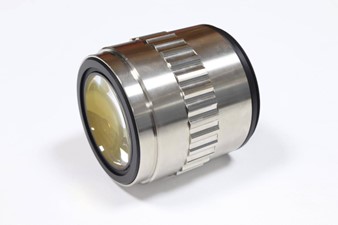

Second-Generation Lens Design
To meet the customer’s expanded field-of-view and precision requirements, Avantier implemented major upgrades:
- Dual-Window Assembly: Two-piece UV windows (6 mm + 3 mm) for stability.
- Material Upgrade: Eco-friendly copper housing for mechanical rigidity.
- Advanced Interferometry Calibration: Real-time monitoring and active centering to minimize tilt and eccentricity.
Performance Highlights:
- FOV: 2.5 mm × 40 µm (8× larger than previous design).
- Distortion: ~1 µm across full FOV.
- NA: 0.47 with strong light collection efficiency.
- Working Distance: 50 mm including window stack.
- Wavefront Aberration: ≤0.07λ (central), ≤0.1λ (edge).
- Transmission: >80% at UV wavelengths.
- MTF: Verified diffraction-limited quality using 632.8 nm interferometry.
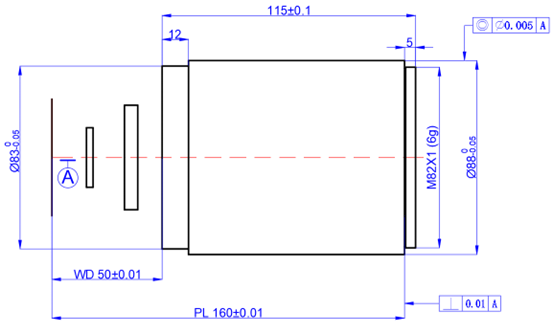
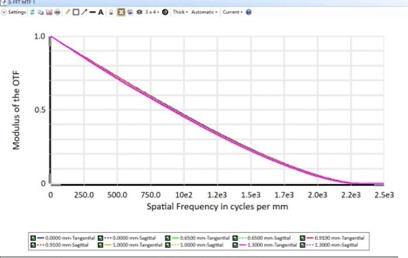
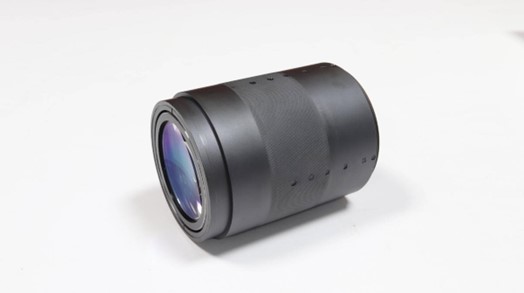
III. Results and Impact on Quantum Computing
- Precision Spot Projection: Delivered 1–1.2 µm Gaussian UV spots with <5 mrad telecentricity.
- Fluorescence Imaging: Enabled high-resolution, low-distortion readout of 397 nm ion emission.
- Scalable Quantum Architectures: Wide FOV supports multi-ion trapping and control.
- Thermal & Mechanical Robustness: Copper housing and stress-free mounting ensure long-term stability.
- Optical R&D Advancement: Pushed limits of UV objective design, supporting both quantum computing and broader fields such as optical lithography and semiconductor metrology.
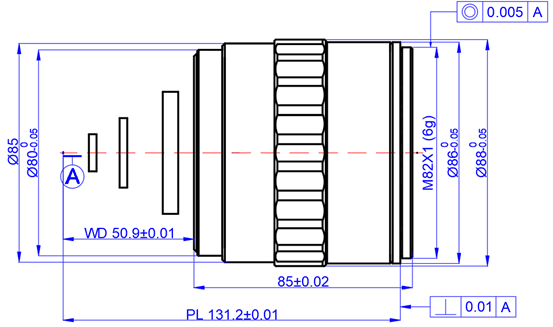
Conclusion: Advancing Ion Trap Research with Custom UV Objective Lens Designs
Long working distance microscope objectives are not just optical components — they are enabling technologies for quantum computing. By delivering high-resolution imaging and precision UV laser excitation in demanding ion-trap environments, they accelerate progress toward scalable qubit systems.
Avantier’s collaboration demonstrates how custom UV objective design can overcome distortion, thermal, and FOV challenges, resulting in diffraction-limited, high-transmission lenses tailored for ion capture experiments.
For research teams advancing quantum computing, photonics, or semiconductor metrology, custom long working distance microscope objectives provide the optical precision required to unlock the next generation of innovation.
Related Content
GREAT ARTICLE!
Share this article to gain insights from your connections!


